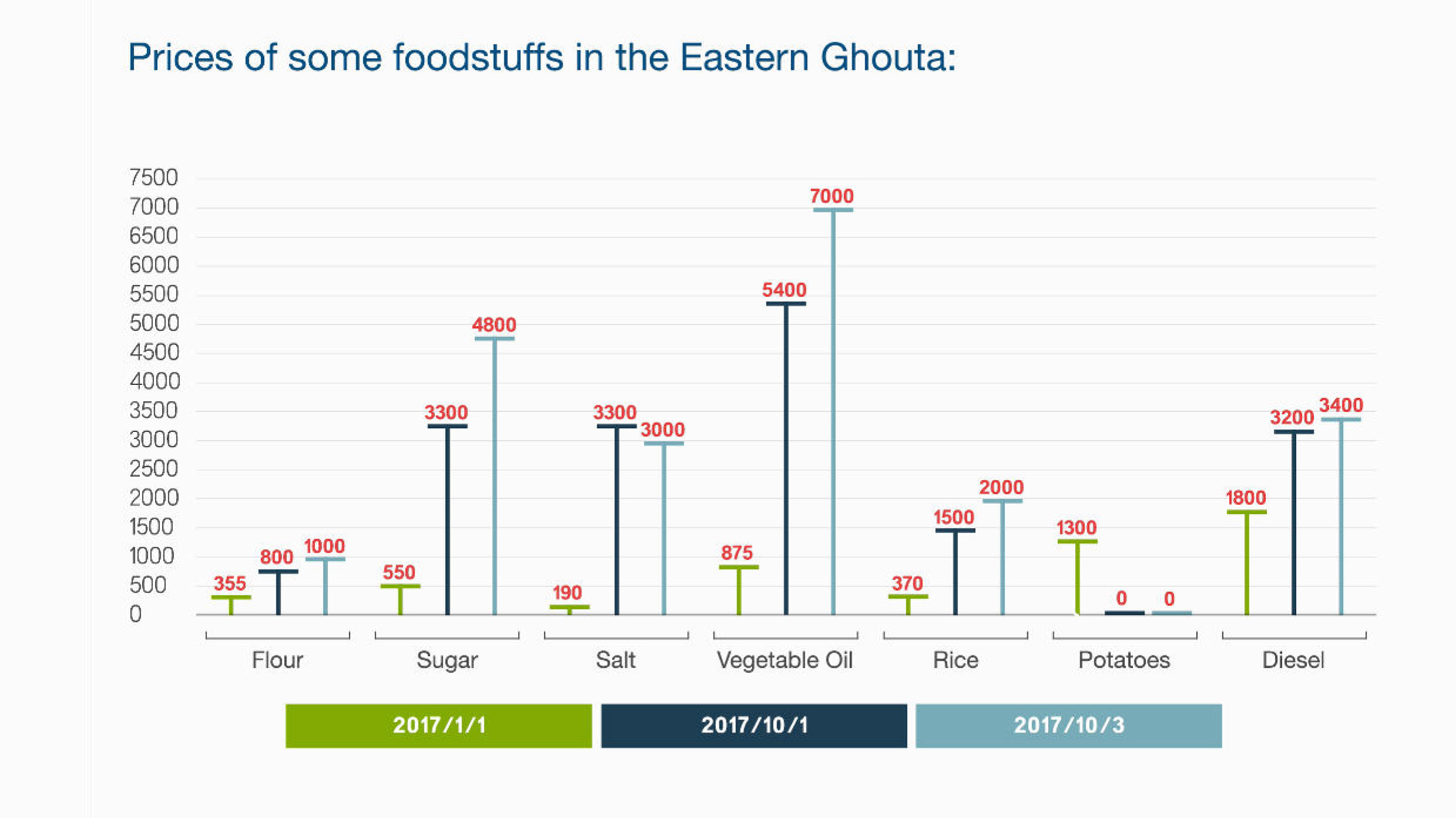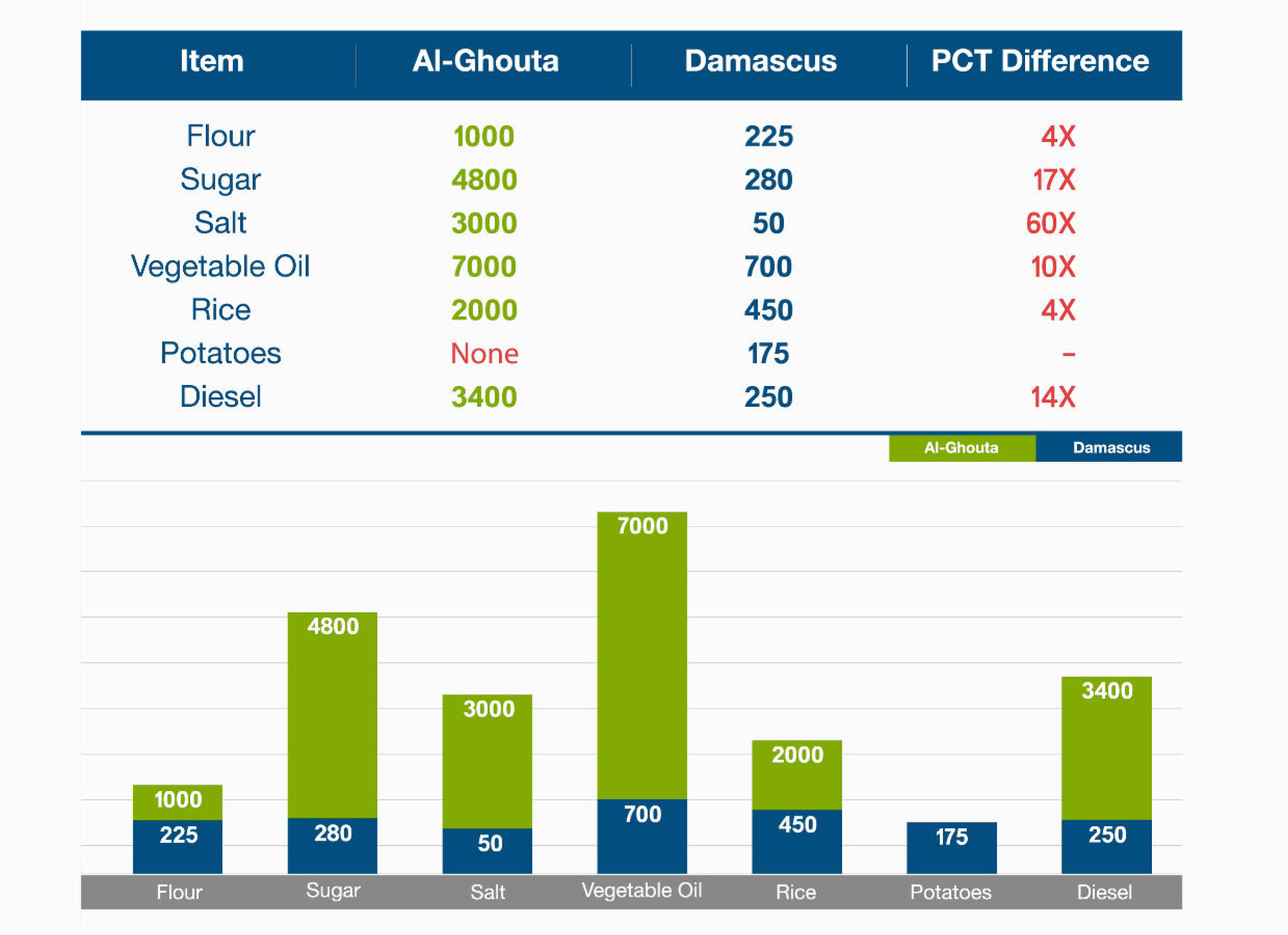- Home
- News
- Humanitarian Reports
- Detailed report about the humanitarian situations in the Eastern Ghouta
Detailed report about the humanitarian situations in the Eastern Ghouta

The Eastern Ghouta area, located near the Syrian capital of Damascus, has been suffering from a four-year very tight blockade imposed by the regime forces, causing difficult humanitarian and every-day living conditions, coupled with closure of crossing points. This situation resulted in the absence of basic needs of living amid increasing demand for them.
The area, which is home to 73,415 families, is under continued shelling, mainly targeting the most densely-populated areas. However, despite the decline in the pace of shelling following the signing of the de-escalation agreement, the bombardment has soon returned to previous intensity.
The Eastern Ghouta has experienced large internal displacement movements, the most severe of which were in the southern and eastern areas of al-Ghouta and east Damascus neighborhoods. The number of internally displaced people from the southern towns of Maliha, Zibadin, Deir al-Assafir and others amounted to 24,975. Other inhabitants, estimated by 40,360, were displaced from the eastern area of al-Marj, Nashabiyyeh, Abbadeh, Otaya and other towns and villages. In addition to that, at least 7,900 inhabitants were displaced from Damascus eastern neighborhoods of Qaboun, Barzeh, Jobar and Ein Terma. This forced evacuation le and displacement led to serious psychological and social impact and consequences as the people moved to other areas unsuitable for living. What is worse is that some evacuees returned to their homes located near the frontlines of the engagement zones.
The closure of the roads and crossing points has caused a sharp rise in the prices of basic foodstuffs and supplies, and their absence from the local markets, along with the decline in the purchasing power of individuals in the Eastern Ghouta. This has increased the cases of humanitarian needs and lack of livelihood and job opportunities, the spread of the phenomena of unemployment coupled with malnutrition, raising the fear of a humanitarian disaster amid total breakdown of sanitation, drinking water network, absence of power and the scarcity of fuel and the sharp rise of their prices.
All of the above-mentioned facts led to an all-out paralysis in the sector of services, transport and agriculture (al-Ghouta's food basket). Under this situation, the local inhabitants resorted to burning plastic materials for the extraction of fuel, creating grave health and environmental risks.
Also the inhabitants of the Eastern Ghouta had started to use firewood as the only alternative material in cooking and heating, though such substitute is not available in the needed quantities, leading to a sharp rise in its prices, and unwarranted cutting of trees, threatening of humanitarian and environmental danger starting with desertification and ending with the absence of heating materials themselves.
The sector of medical services has been greatly affected by the blockade because of the banning of entry of medical supplies into the Eastern Ghouta, in addition to the absence of most of them due to the extensive shelling of densely-populated residential areas, along with the increased risk of injury to the population, and the amputation cases which numbered 5,258. Also the number of the injured and the disabled people amounted to 4,419. Most of these cases were the result of bombardment or lack of quality medicines, as well as the need for some cases for treatment outside the Ghouta.
The students of al-Ghouta in general, and the weak ones in particularly, are seriously suffering from the war. They number a total of 52,000 students. These students are exposed to the strictest psychological pressure, poverty and the need. They are forced to work for living, abandoning their right to education for living and assisting their families. Almost 57% of all schools and places of education were targeted by bombing, increasing the likelihood of students being injured directly or indirectly. This is coupled by long-term psychological effects, along with the destruction of the schools infrastructure and educational facilities. The lack of sufficient staff and educational requirements has a considerable role in the decline of the educational process.
The Siege and its Effects:
- Severe Economic Deterioration:
Targeting major economic infrastructure in one way or another such as hospitals, public roads, factories and public markets through air-raids, the shelling or other attacks, the imposition of severe restrictions on the access points, limits on imports, movements and financial transactions have all disrupted the flow of goods which are necessary for the survival of the civilians, including the raw materials, construction items, and supplies to meet the essential needs. The final result is a fragile economic environment in which commodities are extremely scarce, too expensive and beyond the reach of ordinary people.
In addition, humanitarian organizations face increasing pressures to compensate for the entire business sector, which outweighs their capacities and the appropriate role for action in this humanitarian field.
- Restrictions on Imports and Movements:
Government forces routinely impose very strict restrictions on the movement of people, goods and humanitarian assistance, leading to the complete closure of crossing points. Since the early days of last August, the main crossing of al-Ghouta (known as al-Wafidin crossing of) has been completely closed, with air strikes targeting the infrastructure, including hospitals and markets, further aggravating the humanitarian burden.
On the other hand, the government authorities in Damascus are late, or do not wish to grant permits for the humanitarian activities, including entry visas to humanitarian workers, although these restrictions can sometimes be resolved through dialogue, but the time wasted constitutes an unacceptable burden for the most vulnerable groups in society who are in urgent need to assistance.
The Liquidity Crisis, Shortage in Goods and High Prices:
Conflict, severe economic deterioration and the restrictions imposed on the imports are among the main factors which led to the shortage in key goods and the high prices, making it very difficult for the thousands of those besieged to get food, water, fuels and others necessities. Almost for months the key goods were only available from time to time in most places, as the prices rose dramatically in October. However, many goods have been absent from the markets.
- Prices of some foodstuffs in the Eastern Ghouta

The impact of high prices on families in al-Ghouta is obvious, given the considerable reduction in the purchasing power as the living standards continued to worsen.
At the same time, al-Ghouta suffers from a severe liquidity crisis that has forced people, traders and humanitarian organizations to confront difficulties when transferring cash into the Eastern Ghouta.
The following diagram shows the degree of suffering of the people of al-Ghouta in securing the necessities of daily living through the very big difference in the prices of goods and basic materials between the city of Damascus and the Eastern Ghouta, although there are few meters separating the eastern region of al-Ghouta from the capital Damascus:
The diagram shows the disparity in prices of main goods between Damascus and the Eastern Ghouta

- Collapse of Basic Services and Institutions:
The factors of conflict, displacement and economic collapse are putting severe pressures on the essential services and the institutions providing them, threatening these institutions with total collapse. This reflects on the provision of services in key sectors such as health, water, education and social protection.
As the winter approaches, demands for humanitarian and living needs, heating and clothing materials multiply, accompanied by rising cases of respiratory diseases, resulting in more deaths. The most affected are children under the age of five, so it is necessary to respond immediately before the disaster is in place. There is urgent necessity for meeting the needs and working on solving the problems. These needs have been divided into the following sectors:
- Food Security Sector:
Conflict, insecurity, restrictions on the entry of goods, a collapsed economy, and chronic vulnerabilities are all factors that lead to food insecurity in al-Ghouta.
Food insecurity situation is continuously exacerbated by the irregular availability of basic food commodities, inadequate fuel, lack of access to employment in addition to the disruption of markets and trade in general.
The agricultural sector has suffered a lot from the conflict in Syria in general and in al-Ghouta in particular. It is a sector in which more than 60 % of the population of the Eastern Ghouta work, and is the main source of income for the inhabitants of the southern and eastern regions of al-Ghouta. Agricultural production has declined significantly due to insecurity, high costs, irregular availability of agricultural requirements (seeds, fertilizers, agricultural tools, animal feed, machine rentals and fuel for operating irrigation pumps).
People's needs for food are increasing as winter approaches, in conjunction with the lack of winter agricultural crops, leading to a sharp rise in the prices of food items, the most important of which is the bread loaf, and lack of flour which is the main source of food for the people of al-Ghouta. This is coupled with the loss of most vegetables and summer fruits. An emergency response to avoid tragedy and turn it into a food disaster could be as follows:
- Help in securing bread for the whole population.
- Provide cooked meals or food items to vulnerable families.
- Ensuring the requirements of cooking, like firewood and other sources.
- Internal Displacement Sector:
The current number of internally-displaced people amounts to 78,911, or 18.9 % of the total population of the Eastern Ghouta. Displacement alone is not an indicator of poverty but is an important risk factor, particularly when displacement extends for longer periods. Displacement for 90 per cent of the evacuees have so far been extended for over a year, amid severe economic decline and long-term displacement. Those displaced, along with their hosts are rapidly draining the reserve quantities of foodstuffs and other materials. And those who cannot afford the rented accommodation or living with the host communities are the most vulnerable.
Many internally-displaced people live in public buildings, schools or community centers. Services at these sites are usually limited. They face significant protection risks, including loss of means of living, disruption of schooling and insecurity.
Farmers fleeing from the southern and eastern areas of al-Ghouta constitute 83 % of the total internally-displaced population. They were forced to leave their lands because of insecurity and conflict. These farmers used to depend on their orchards, farms and animal products for living as their primary source of income. Their displacement caused deterioration of the economic situation and the spread of unemployment.
Winter is one of the worst humanitarian conditions for the internally-displaced people. Some of their urgent needs are to be met as follows:
- Providing adequate shelter for them.
- securing the basic services of sanitary facilities and potable water.
- The Health Sector:
The coming of winter is a problem that can worsen the health situation as the diseases are multiplying, along with the causes of infection. This period is characterized by the spread of respiratory and pulmonary infections and severe influenza cases that require medical attention amid almost total loss of medical services. The health crisis causes problems especially for the most vulnerable groups such as children, the elderly, the women and those patients with special needs, and those with chronic diseases such as asthma and upper respiratory tract infections.
Al-Ghouta also suffers from continued shelling and escalation, which increases the number of injured on a daily basis and increases the extent of medical and medicine needs. The closure of roads for long periods and the partial entry of convoys of medicines into al-Ghouta is a complete loss for many types of medicines, especially pediatric medicines, heart medicines, high blood pressure, anti-biotic as well as the rise of their prices. There are 252 cases of critical medical conditions which require immediate treatment outside al-Ghouta.
During the conflict, basic infrastructure, water supplies, sanitation and hygiene services were damaged, leading to increase in malnutrition rates, indirectly associated with contaminated drinking water and deteriorating sanitation and hygiene.
The response to prevent further deterioration of the health sector can be done through:
- Providing minimum safety and protection from diseases and epidemics through health aid.
- Assistance in the provision of medicines and general antibiotics.
- The Education Sector:
Winter is a risk factor for the educational sector as a whole, sometimes leading to the suspension of the educational process due to the harsh conditions and the lack of rehabilitation of schools to make them resistant the cold, and the lack of heating materials, scarcity and the lack of winter clothing for all students as a result of poverty and siege.
Furthermore, meeting the needs of students helps support the organized attendance of school and pushing education forward to provide education for those aged 7 to 17 years. This can be carried out by:
- Providing winter heating materials for schools.
- Providing winter clothes for all students, especially for students of the most vulnerable groups.
- Rehabilitation of schools to make them resistant to cold.
- The Shelter Sector and Non-Food Items:
As a result of the shelling of residential houses, and the waves of internal displacement, those displaced are forced to live in homes not qualified to live in, or damaged due to bombing. It has become a necessity to respond quickly to these needs to make such places suitable for living in dignity, and providing the necessary heating materials, which are experiencing high prices due to the high demand amid their scarcity in the markets. This must be addressed by:
- Rehabilitation of houses and making them resistant to cold
- Providing the heating materials for homes
- Insuring clothing and winter supplies, including blankets and special protection covers.
- The Protection and Childhood Sector:
Children are the hardest hit and affected by war, siege and the most vulnerable as they suffer from employment, lack of education, poverty, need, destitution and the dangers of injury due to systematic bombing. They also suffer from psychological illness because of panic when they hear the roar of planes and guns. In many cases, children are the victims themselves.
Workers in the humanitarian field can provide protection and care through:
- Ensuring adequate housing and decent living
- Ensuring the appropriate environment for education
- providing protection and care for the rights of children.
finally
We provide the organizations working in the humanitarian and human rights fields this report, which directly highlights the human suffering being experienced by the inhabitants of the Eastern Ghouta. The effects of this situation have been deteriorating every day as a result of the imposed siege and the daily bombardment despite the recent signing of the de-escalation agreement. We call upon them to shoulder their responsibilities in protecting the civilians and providing the humanitarian response in the needed quality to overcome this deteriorating situation, otherwise we will be in the process of a catastrophe that is marked as a stain for the humanity.
----------- THE END -----------







